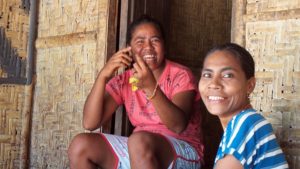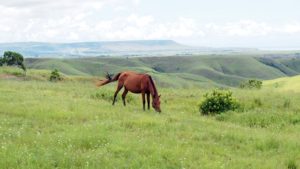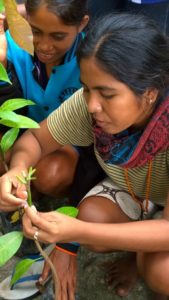
The unique knowledge of the women of East Sumba, Indonesia, is being recognized in the restoration of their deforested land.
The high plateaus of East Sumba in Indonesia, especially on the way to Haharu subdistrict, are very beautiful. On either side of the narrow road, an expanse of savannah stretches wide. During the brief rainy season, herds of the small, brown sandalwood pony and large, white, humped cattle graze freely. It is a green and neat landscape, with short grass, scattered shrubs and a few clumps of tall trees, such as kehi (Lannea coromandelica) and kosambi (Scheilechera oleosa).
At first glance, the grass looks deliberately planted, although in reality it and some of the woody species regenerate naturally in the rocky, limestone soil. Some limestone outcrops appear on the surface, reaching heights of 1 to 3 meters, giving the impression of a stone forest.
This charming landscape, unfortunately, does not promise a decent living for the people who inhabit it. They live in poverty because the productivity of the land is very low. Most of the people have difficulty even finding sufficient clean water; some villages have no water sources at all. The limited tree cover in the rocky landscape results in limited capacity to store water. The island has been largely deforested, beginning with the Dutch in the 1700s exploiting the sandalwood and continuing after independence up until the early 2000s, by which time there was nothing left to take.
In response to these at once beautiful and harsh conditions, Wahana Visi Indonesia in partnership with the World Agroforestry Centre (ICRAF) and Lutheran World Relief are developing a model of environmental and landscape restoration that incorporates improving the livelihoods of the people. With support from the Australian Government, ICRAF’s role in the Indonesia Rural Economic Development project, part of the CGIAR Research Program on Forests, Trees and Agroforestry (FTA), is to help farmers establish trees that they have prioritized as economically, culturally or environmentally important.

Tree seedlings produced in community and farmers’ nurseries are planted on private or community land and can also be sold to earn additional income while waiting for the saplings to grow to harvest age.
Improving land and environmental functions by empowering local people — whether men or women — is not easy to do. Understanding the socio-cultural issues in a community is important, especially the roles of women because they are often an overlooked resource who can make a significant contribution. Men and women have different strategies and approaches to valuing, using and maintaining the environment to sustain their livelihoods.
In Sumba, ICRAF conducted a gender study that did indeed find great potential for the involvement of women in landscape restoration. Sumbanese women play very important roles in the management of land and natural resources, although they are frequently not visible. They are tough and work actively on their land, in addition to their household tasks, providing important contributions to planting and harvesting, work that requires intense labor.
They are also involved in managing chickens, pigs and dogs and, particularly, with the management of waste from cattle and goats. Women are responsible for providing water for all the livestock. Yet despite their significant roles, few women have opportunities to receive agricultural training. They are usually involved in support roles, such as preparing meals for the training session.
Partly this is a class issue in that Sumba is traditionally a stratified society and social classes remain important in some villages. The classes are closely related to the management of land and natural resources. The maramba are the highest social group, consisting of ‘nobles’ who control large amounts of natural resources. The kabihu is the class of ordinary people, who conduct their own economic activities freely. Ata are indentured laborers or slaves who attend on the maramba. The ata are usually supported financially by the maramba but they cannot freely choose their work.
Vel and Makambombu (2009) stated that unmarried ata women and men have weak positions in local customary law so their role in making decisions is limited. This social structure is now not as strong, with many villages dominated by the independent kabihu. The ata, vassals of the maramba, are declining in number. The times are changing.

The role of women is also gaining greater general recognition. Two women were selected to join a seven-member team, led by ICRAF, that visited the much larger island of Sulawesi, because they were leading farmers and key community members.
The visit, and subsequent land-management activities involving more women, has led to wider recognition of the unique knowledge and experience held by women; it is now openly acknowledged that women have knowledge not readily available to men. They are able to participate in nursery activities without any cultural barrier stopping them from leaving their villages.
However, women’s involvement in public life is still limited. Public meetings remain the domain of men, with most women too shy to express their ideas and argue their case. But in training sessions divided into groups by gender, women are more open in expressing their views. It is reasonable from this to conclude that women’s involvement in public life strengthens their opportunities and their confidence in sharing their knowledge.
ICRAF’s gender study recommended some strategic approaches to increase women’s visibility and involvement. First, to continue raising local awareness of women’s unique knowledge and facilitate their involvement in decision-making in public life, particularly for restoring landscapes and improving livelihoods. But any changes to women’s roles should not increase their burden. Second, encourage an increase in men’s involvement in domestic activities so that women and men can work together both inside and outside the household.
Practical approaches include women being in charge of filling planting media, sowing seeds, watering, transferring seeds to media, and weed control.
Meanwhile, men could be responsible for the preparation of the nurseries, such as preparing the land, building the shade house, preparing the soil and manure for the planting media, and ensuring water was available. Women could also be more actively involved in accessing information and agricultural extension services, for example, organizing more training to fit women’s availability and, for certain activities, separate men and women into different groups.
In many parts of the world, including Sumba, it has often been easily overlooked that local communities who manage land are not only made up of men. Restoring the functions of a landscape must involve all members of a community who live and work in it and take into account the varying details of the social order.
Communities are the main actors in their own development because they are the ones who best understand the local physical, social and cultural environment, which are all important factors in restoration. Understanding the role of women and men as similar yet unique actors is necessary for developing sound strategies for managing land and natural resources, including restoration.
By Elok Mulyoutami, edited by Rob Finlayson, originally published at ICRAF’s Agroforestry World.
This research forms part of the CGIAR Research Program on Forests, Trees and Agroforestry. We would like to thank all donors who support this work through their contributions to the CGIAR Fund.











